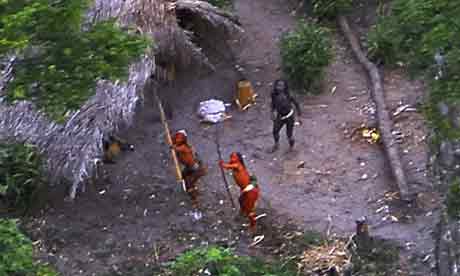Brazil uses heat-seeking planes to uncover Amazon's lost tribes
- guardian.co.uk, Wednesday November 19 2008 14.16 GMT
-
 larger | smaller
larger | smaller

Members of a previously unknown Amazon tribe aim arrows at a plane in May 2008. Photograph: Reuters/handout
The Brazilian government is set to employ heat-seeking sensors in a last-ditch attempt to save the country's remaining groups of isolated Indians.
The instruments will be mounted on a Brazilian air force jet normally used to monitor rainforest destruction with the aim of locating an estimated 39 groups of isolated indigenous people, who live hidden deep in the country's sprawling Amazon rainforest.
Authorities hope the system will help them pinpoint the location of groups of un-contacted or isolated Indians in order to protect them from invaders such as loggers, gold-miners and ranchers.
Antenor Vaz, the coordinator for isolated tribes at Brazil's National Indian Foundation, said the system would allow authorities to locate tribes without disturbing their way of life.
"We have been using planes more and more, not just to monitor [isolated tribes] but also to find new references," he said.
But even the use of small planes brought "disruption" to the tribes because they flew at low altitude, he said.
Brazil's isolated Indians hit the headlines in May when aerial photographs of a tribe near the remote border with Peru were released. Several of the tribesmen could be seen firing arrows at the plane.
Mr Vaz said the use of body-heat sensors mounted on planes flying at high altitude meant the tribes would not even know they were being monitored.
Campaigners say Brazil's Amazon is home to the largest number of un-contacted tribes in the world and authorities have long grappled with the dilemma of how best to treat indigenous groups who have had little or no dealings with outsiders.
For hundreds of years colonizers and explorers have trekked through the Brazilian jungle coming into contact with isolated tribes, often with disastrous results. Western diseases such as flu have devastated many indigenous communities.
In recent years government policy towards un-contacted tribes has shifted to one of 'no contact'. A handful of sertanistas. or explorers, work in the rainforest trying to locate tribes without coming into direct contact with them.
Mr Vaz said the heat seeking technology's first mission would be to confirm the existence of isolated tribes in the Amazon state of Mato Grosso, a region that loggers, ranchers and soy farmers have turned into ground zero for rainforest destruction.
"The priority will be Mato Grosso where the process of devastation is happening quickest," he said.
In an interview with the Brazilian newspaper Folha de Sao Paulo the president of Brazil's National Indian Foundation, Marcio Meira admitted time was running out for the region's isolated tribes.
"The situation there is an emergency," he said.
